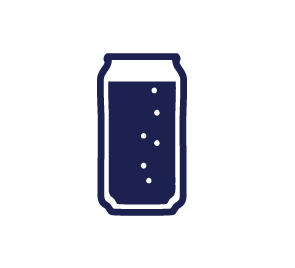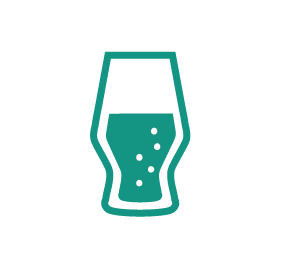Tips to Drink in Moderation
Over 100 young adults from all over New Hampshire have shared the things they do to drink moderately.
Here are their tips to avoid and prevent binging:
PACE YOURSELF
Drink slowly. Take a few sips at a time and make each drink last one hour. Have a non-alcoholic drink such as soda or water (or even a mocktail!) in between every alcoholic drink.
KEEP TRACK
Keep track of how much and how often you are drinking. You can write it down, tell a friend, track it in your phone, save your beer caps or download one the apps designed to track quantity.
How much is 1 drink?
(beer can vary widely in ABV and therefore in serving size, with some being comparable to wine in alcohol content)

341 mL = 12oz
5% or less alcohol

237-296 mL = 8-10oz
7% alcohol

142 mL = 5oz
12% alcohol

85 mL = 3oz
16-18% alcohol

43 mL = 1.5oz
40% alcohol
KNOW A STANDARD DRINK SIZE
Don’t super-size it! Make sure you know how much you are really drinking. Most drinks you are served are actually larger than a standard serving size. Also, many craft beers have a higher alcohol content. A regular 12 fl oz of beer contains 5% alcohol which is about the same amount as a 5 fl oz glass of wine. For the most part, one standard drink equals one 12 fl oz beer, one shot, or one 5 fl oz glass of wine.
STAY HYDRATED – DRINK WATER
There are many factors that influence blood alcohol content. The amount of water in your blood is one of them. This is partly why women feel the effects of alcohol sooner – they have less water in their blood. Make sure to drink plenty of water while you are drinking alcohol.
EAT FOOD
You should never drink on an empty stomach. Eating food with protein helps to slow down the absorption of the alcohol and avoid a rapid peak in blood alcohol concentration. This will help you avoid black outs.
LOOK OUT FOR EACH OTHER
Going out with friends you trust helps you stay in control, keeps you on track, and holds you accountable. When drinking is involved, you are more vulnerable, so make sure you and your friends get home safely.
KNOW YOUR MOOD
Your mood can impact how much you drink and how you respond to alcohol. Feeling sick, depressed, anxious, or sad? Had a recent sad event or loss? Are you feeling social, celebrating an accomplishment, chilling out, relaxing, or bored? Drinking when you are not in a good mood or sick will make you more depressed and can result in binging. Learn more about Stress, Anxiety, and Alcohol.
AVOID USING ALCOHOL & MARIJUANA TOGETHER
Using alcohol and marijuana together is not a good combination. Studies have shown that when young adults use the two together, they have a higher risk of negative consequences including driving under the influence, blacking out, throwing up, or negative social effects.
CHANGE YOUR ENVIRONMENT
Whether we realize it or not, certain places, people, and events can be triggers that lead to binge drinking. Think about where, when, and with whom you spend most of your time when you drink too much. Being around these triggers can make it difficult to drink in moderation.
REWARD YOUR ACCOMPLISHMENTS
Positive reinforcement can go a long way in staying on track and keeping yourself motivated. If you’re setting and reaching goals, reward yourself (you can use some of the money you’ll save by cutting back on drinking!).
